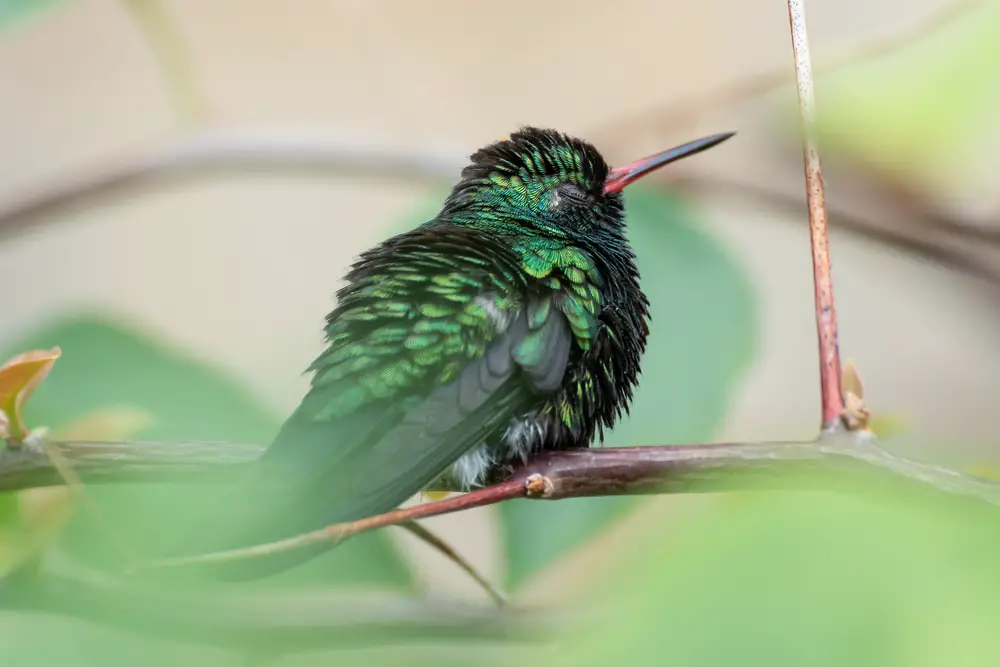Torpor is how hummingbirds conserve energy. All species of hummingbirds enter torpor at night, during cold weather, or when food sources are low. Torpor presents some risks to hummingbirds, but the benefits are enormous—allowing these creatures to survive dire circumstances for brief periods.
Hummingbirds are high-energy, flying around and using food sources quickly. To sustain their body mass, they enter a state called torpor. Torpor preserves their fat stores and allows them to survive overnight. Read on to find out more about hummingbird torpor. Find out how these tiny birds save energy and protect themselves in various circumstances.
Table of Contents
What Is Hummingbird Torpor?
A Hummingbird torpor is when the hummingbirds metabolic rate slows down dramatically to conserve energy. A hummingbird will go into a state of torpor every night when it goes to sleep in order to make the stretch of so many hours, typically 5-10 hours. A hummingbird can not go without food for 5 hours as it is likely to perish from a lack of nourishment.
Torpor is a almost like a hibernation-like state, but instead of the animal going through a period of months to conserve energy, the period is frequent and short-lived. Hummingbirds in torpor enter into a deep sleep where they can not move and be unresponsive. Hummingbirds enter torpor overnight or on cold nights. Every species of hummingbird uses torpor as a way to stay alive.

What Is The Purpose Of Torpor?
The purpose of torpor for hummingbirds is to:
- slow heart rate
- lower ambient body temperature
- decrease breathing/lessens oxygen consumption
- slow metabolic rate
Hummingbirds enter torpor as a way to conserve energy—either overnight or from cold temperatures. They can also enter torpor when food sources are scarce. A hummingbird’s body needs an incredible amount of food to survive. Hummingbirds typically expend a lot of energy hovering around and over tubular-shaped flowers.
The energy required to keep flight results in the hummingbird’s extremely fast heart rates. During flight, a hummingbird’s heart rate will increase to approximately 1200 – 1260 beats per minute. During their slowed state of metabolism, when they do not move and stay perched for hours during the night – hummingbirds’ heart rates will slow to about 50-180 beats per minute.
Because hummingbirds have such a fast heart rate, they often eat up to 3 times their body weight daily to maintain their basic homeostasis. Hummingbirds frequently eat about every 15 minutes as they can not go over 5 hours without nourishment. At night, hummingbirds will sleep and cannot eat with such frequency. Entering torpor slows their metabolic rate by as much as 95% and decreases their breathing rate.
Torpor is more than simply a hummingbird sleeping. In a torpor state, hummers are unresponsive and vulnerable to predators. It can take as much as an hour to come out of torpor, and the hummer’s body must exit torpor correctly, or it will die. The colder the morning is, the harder the hummingbird must work to come out of torpor, and feeding immediately becomes critical.
Daily Torpor Vs. Deep Torpor
Numerous animals enter daily torpor, cooling their body temperate to conserve energy while they sleep. They can lower their metabolic rates by up to 30%, keeping their energy reserves as high as possible for the next day.
Hummingbirds, on the other hand, are the only birds to enter deep torpor. In a deep torpor state, their body temperature drops to 50 degrees below their normal daytime temperature, or ambient temperature, of around 100 degrees Fahrenheit.
In the high elevations of the Andes Mountains, researchers observed the lowest known metabolic rate for an avian species in the Blacktail Hummingbird. This particular hummer had a body temperature slightly under 40 degrees Fahrenheit.
What Happens To A Hummingbird’s Heart Rate When It Goes Into Torpor?
Hummingbirds have the highest heart rate of all bird species and vertebrates’ second highest heart rate. The Blue-throated hummingbird’s heart rate has been recorded at 1260 beats per minute—the fastest of all hummingbirds. In torpor, a hummingbird’s heart slows to as much as 5% of its normal heart rate. By slowing their metabolic rate and heartbeat and lowering their body temperature, hummingbirds can conserve enough energy to sustain their body overnight or in case of cold temperatures.

Do Hummingbirds Go Into Torpor Every Night?
Yes. Torpor is a necessary state that hummingbirds must enter to survive overnight. Their metabolic rate is so high that they must conserve energy at night to survive since they are unable to feed and keep their bodies functioning.
How Does A Hummingbird Wake Up From Torpor?
A hummingbird’s biological clock reverses torpor about an hour or two before the sun rises. The hummer’s wings vibrate to increase body heat, and its heart rate and breathing increase. It takes about 30 minutes for hummingbirds to get active after being in a state of torpor.
After they are out of torpor, hummingbirds go right to their selected food source and consume 25% of their daily intake of nectar and available insects.
How Long Can A Hummingbird Stay In Torpor?
In general, hummers stay in torpor for 5-10 hours. In fact, the longer a hummingbird stays in torpor, the more energy they save. Hummingbirds go into torpor automatically as night falls. In fact, if they are still tanking up at a feeder, they may not be able to make it back to their nest in time. If this happens, they can end up hanging upside down on the feeder perch!
What Are The Risks Of Torpor?
Torpor is more than simply a hummingbird sleeping. In a torpor state, hummers are unresponsive and vulnerable to predators. It can take as much as an hour to come out of torpor, and the hummer’s body must exit torpor correctly, or it will die. The colder the morning is, the harder the hummingbird must work to come out of torpor, and feeding immediately becomes critical.
Torpor As A Tool For Migration
A study by Sarah Hiebert examined the use of torpor in the Rufous Hummingbird. Hiebert found that hummingbirds use torpor more frequently in the autumn to build up fat stores for migration. The Ruby-throated Hummingbird, for example, migrates over 3,000 miles from Canada to Costa Rica. Before these tiny birds begin such a long journey, they must make sure they have enough fat reserves.
Should You Wake A Sleeping Hummingbird?
If you happen to come across a hummingbird perched and unmoving, the hummingbird is in torpor. Don’t disturb the hummingbird—simply walk away. Hummingbirds can survive even during moderate cold snaps by using torpor.
If hummingbirds are in your area and the weather turns cold, the best thing you can do is to keep feeders filled with fresh hummingbird nectar—hummingbirds know how to survive!
Ornithology has taught us much about the hummingbird species. Researchers continue to study torpor, as well as numerous other aspects of these tiny birds, in hopes of better understanding hummingbirds and their greater role in our world’s ecology.

